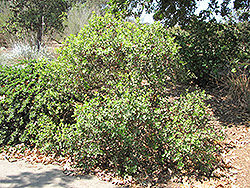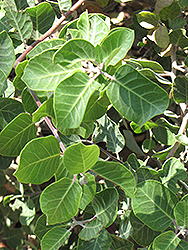It's all about ...
plants

Height: 8 feet
Spread: 12 feet
Sunlight:
![]()
![]()
Hardiness Zone: 9a
Description:
A large, rounded evergreen shrub featuring pale blue-green leaves on reddish stems, and a colorful display of bright pink flowers in late winter to early spring; low water needs and very drought tolerant; a great specimen that can be used on slopes
Ornamental Features
Pink Flowering Sumac features showy clusters of pink star-shaped flowers with scarlet eyes at the ends of the branches from late winter to early spring. It has attractive bluish-green foliage with chartreuse veins which emerges light green in spring. The oval leaves are highly ornamental and remain bluish-green throughout the winter. It produces red berries from early to mid summer. The smooth brown bark and dark red branches add an interesting dimension to the landscape.
Landscape Attributes
Pink Flowering Sumac is a multi-stemmed evergreen shrub with a more or less rounded form. Its average texture blends into the landscape, but can be balanced by one or two finer or coarser trees or shrubs for an effective composition.
This shrub will require occasional maintenance and upkeep, and should only be pruned after flowering to avoid removing any of the current season's flowers. It is a good choice for attracting bees, butterflies and hummingbirds to your yard. It has no significant negative characteristics.
Pink Flowering Sumac is recommended for the following landscape applications;
- Accent
- Mass Planting
- Hedges/Screening
- General Garden Use
- Naturalizing And Woodland Gardens
Planting & Growing
Pink Flowering Sumac will grow to be about 8 feet tall at maturity, with a spread of 12 feet. It has a low canopy, and is suitable for planting under power lines. It grows at a medium rate, and under ideal conditions can be expected to live for approximately 30 years.
This shrub does best in full sun to partial shade. It prefers dry to average moisture levels with very well-drained soil, and will often die in standing water. It is considered to be drought-tolerant, and thus makes an ideal choice for xeriscaping or the moisture-conserving landscape. This plant does not require much in the way of fertilizing once established. It is not particular as to soil type or pH. It is highly tolerant of urban pollution and will even thrive in inner city environments. This species is native to parts of North America.
This plant is not reliably hardy in our region, and certain restrictions may apply; contact the store for more information.

